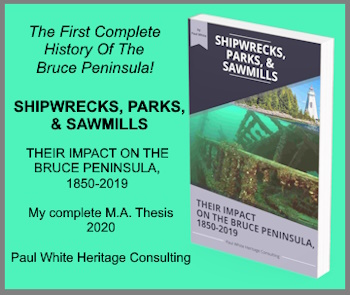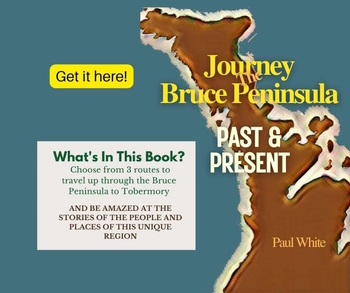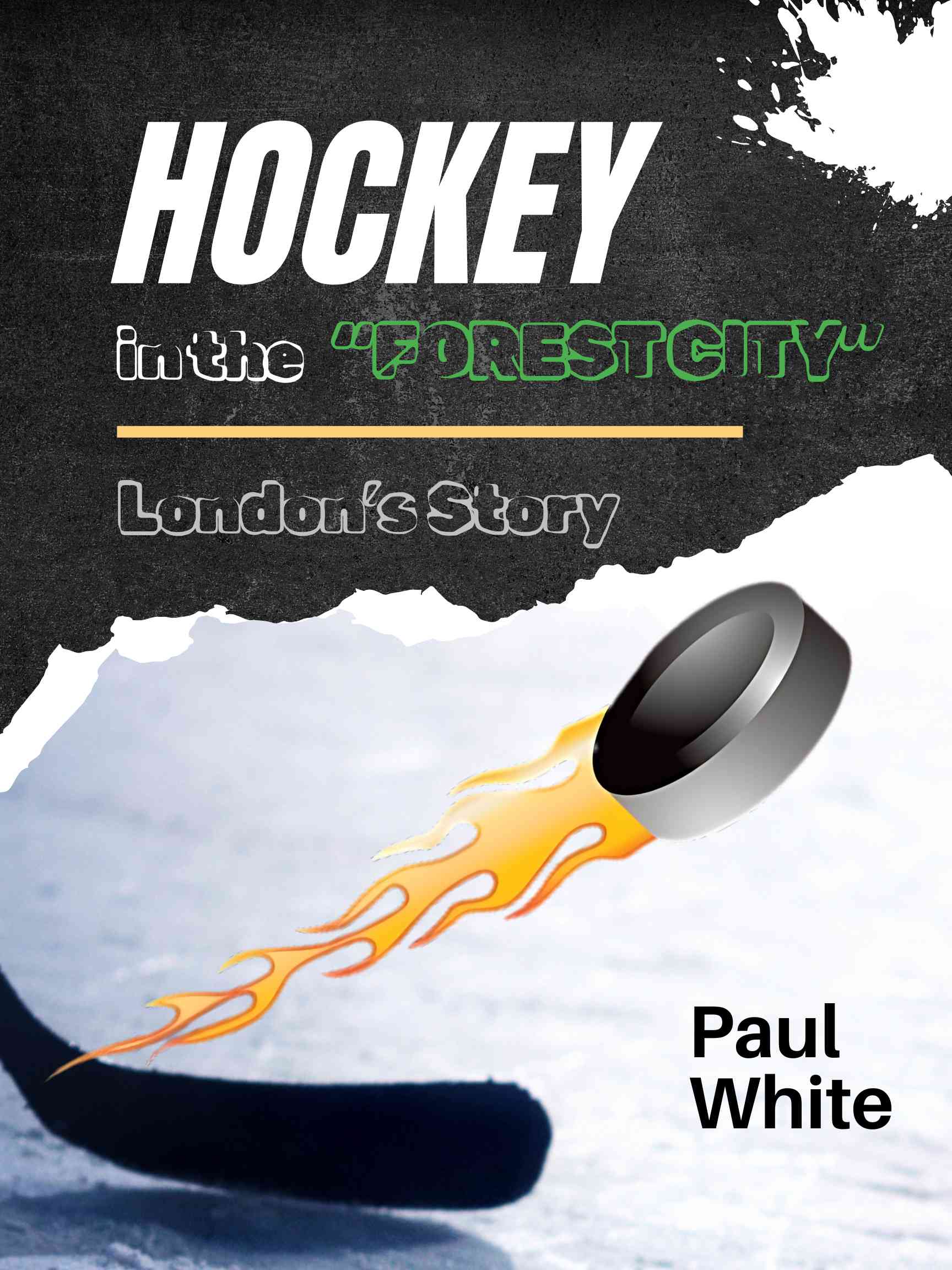Pioneer Healthcare
in Grey and Bruce
Pioneer Healthcare in Grey and Bruce counties was not administered by doctors, nurses, or pharmacists, no it was the responsibility of the women of the community.
This winter, the flu has taken its toll. To avoid becoming ill many people went to their doctors for a flu shot.
Those who fell victim to the influenza epidemic which spread across North America depended upon local pharmacies for medicine to reduce the aches and pains associated with the illness.
In North America, doctors and pharmacies are an important part of every community. In fact, they are both considered essential services for any area.
However, in the early days in Grey and Bruce, neither doctors nor pharmacies were a luxury enjoyed by the settlers of this region. Who filled the role of doctor and pharmacist in the pioneer settlements of Grey and Bruce? Most often it was the women of the community who provided pioneer healthcare. In each settlement there was usually one or two women who served as midwives and delivered many of the babies born into pioneer families.
However, it was usually the mothers and grandmothers who tended to the illnesses suffered by family members.
Nature Provided Cures for Pioneer Healthcare
The general stores did not carry pain killers or vitamins. Instead, the treatments used to heal the maladies which struck during that era were concoctions developed in the kitchens of the settlers' homes.
The ingredients used came from products used in the home and from plants that were either grown in the garden or found in the nearby forests.
Although many of these homemade medications were the result of trial and error, many were recipes which had been handed down from one generation to the next.
The early settlers also learned of the medicinal value of certain plants from the natives who lived in the area.
One of these native remedies was a tea made from the seeds of the plantain plant, which was a cure for diarrhea. The natives also boiled chips of sassafras or Spicewood bark to purify the blood. They also smoked mullein leaves to relieve congestion and used dried puffballs to stop bleeding.
Today, sufferers of indigestion have a choice of numerous tablets and liquid remedies available at every variety store. In the early days, hop tea was used to relieve digestive problems.
To relieve the pain of bruises and swelling, a concoction was made with smartweed steeped in vinegar. Another pain reliever was a salve made of black alder, lard, resin and beeswax.
To draw out an infection, a poultice made of either crushed plantain or bread was applied to the injury. If the wound was open, peat moss was used to dress the cut.
When a member of the family caught a cold, the mother of the family administered a syrup which she made from the roots of the spikenard and the tuber of the bloodroot. Other cold remedies were catnip, hemlock and pine bough tea.
When I was a youngster, I had the opportunity to experience first hand one of these pioneer treatments. I had been sick for several days with a high fever. My grandmother decided that the only remedy was one which she had without a doubt learned from her mother.
When she arrived at our house, she told me that she would make something which would make me feel better. After that pronouncement she headed to the kitchen. Soon the house was full of the aroma of onions.
When my grandmother next appeared, she was carrying a cloth from which even the most blocked nasal passages could detect the smell of onions. Grandmother was about to apply an onion poultice to her unwary grandson.
The heat and the reek of onions was almost more than I could bear, but it was not long after the ordeal that I was feeling considerably better and the fever had disappeared.
To this day I still wonder if that onion poultice really cured me or whether I felt better just because I dreaded another visit from grandmother and her remedy!
The information in this article came from many sources, (including my childhood memories). However, Normanby Reflections; A History of Normanby Township was of primary importance.
A version of this article originally appeared in my Local History column in the Owen Sound Sun Times on January 28, 2000.
More Grey County Pages
12-year-old Walks to Owen Sound in 1851 from the journal of a teenage boy's experience travelling with his brother in the untamed Upper Canadian wilderness.
1st Grey County Building in 1852 was only built after many hurdles were overcame.
Dr. Anna Henry from Markdale, was a medical trailblazer for women doctors in Canada, who helped lay the groundwork for the establishment for Women's College Hospital.
Egremont Township endured the usual growing pains of a pioneer community, but its early history records times when it was embroiled in a few contentious issues.
Euphrasia Township in the early years when spelling the name was a problem for those who called it home and those that wanted settle this new Grey County township.
Georgian Bay's 1st pioneer settler arrived on the western shoreline long before any other settler reached the area.
Grey County Heritage: A Valuable Resource which is rich and varied, as an important resource for future use for business, political, and many other purposes.
Grey County's Creation in 1852, laid the framework for organizing a county in the last wilderness in the southern region of what would become in the future the province of Ontario.
An Unlikely Hero From Grey County (Part 1) found his way from the farming community of Flesherton to missionary work in the Ottawa Valley, and beyond.
An Unlikely Hero Vs. The KKK (Part 2) Our hero from Grey County took his missionary zeal south of the border and ultimately crossed paths with the infamous KKK!
Barn Raising: A Pioneer Economic and Social Necessity as it provided settlers with an opportunity not only to build a barn, but also build a community.
"Barring Out": A Pioneer School Tradition was a custom which the settlers brought to the new world from England, or Scotland.
Ceylon Ontario: How it Got its Name: It is always interesting how a community got its name, but I doubt any place received its name from a more unique source!
Chatsworth Ontario: First Settlers took advantage of fulfilling the needs of pioneer travellers and built a thriving community in the Upper Canadian wilderness.
Clearing Trees a Daunting Task for Settlers as they worked to fulfill their obligations for their land grant.
Dornoch: or is it Smithville? Originally it was Smithville, then it became Dornoch. But, surprise it is still, in reality Smithville!
First Pioneer in Durham: Archibald Hunter established his family, and a hotel, in what would become the centre of the town of Durham.
Durham Ontario Influenced by the Saugeen River. This river provided a means to create new industries, but especially in the spring it can also pose a menace to the community.
Grey County Bylaws to the 1890s reveal a lot about the financing of local government, especially education in the early days of the region.
John Muir, the legendary naturalist, who promoted the idea of protected nature spaces, spent time in Ontario and I went to help find evidence of his stay in the Owen Sound area.
A Heroic Woman From Grey County who made great changes as a doctor in China in the 1890s and early 1900s.
Jesse James: In Grey County? An interesting question. Did the notorious gangster hide out in Proton Township? We will never know. But it is fun to speculate!
Kilsyth's Train Engine was one for the history books. It brought an evening of joy followed by disappointing news soon after.
The Knight's of Meaford have long history in that Grey County community. Their business forged by early settlers employed many locals and supported the economy.
Leith: Tom Thomson's Birthplace is part of the rich heritage of this community located on the east shore of the Georgian Bay north of Owen Sound.
The Leith Golf Course has provided many families with great memories. The history of this golf course starts, and ends, with the generosity of one family.
Agnes Macphail was a political trailblazer in a part of Ontario that one could hardly expect such radical action for the era in a rural region.
Markdale Ontario: The Beginning: originally known as Glenelg East, but the coming of the railway and the name of owner of the land for the station led to a change of identity.
Meaford's history is one of hardy and entrepreneurial pioneers carving their lives out of the wilderness of what would become Grey County.
Meaford Ontario, first called Peggy's Landing located on the shores of Georgian Bay has a rich history.
Meaford vs Purdytown. Conflict over the name of a new community was not unusual in early Grey County but electing a school trustee was the "hot button" issue in this rivalry.
Pioneer Clergyman: John Neelands was the first to minister to the first settlers' spiritual needs riding on horseback through the wilds of early Grey County.
Pioneer Doctor: Dr. James Smith, a local boy who became a doctor and served his community for his entire life was a testament to Grey County community spirit.
Pioneer Healthcare in Grey and Bruce counties was not administered by doctors, nurses, or pharmacists, no it was the responsibility of the women of the community.
Pioneer Homes in Grey County in the 1840s offered only basic amenities. Homes were basic because clearing the land to earn a living to survive were of paramount importance for those embarking on a new life.
Pioneer Ingenuity created many labour saving devices and methods and quite often helped to create a sense of community.
Pioneer Christmas: A Family Tradition as told to me by may grandparents who experienced Christmas as children in the 1880s and 1890s.
Pioneer Settlement Plans for Grey County began almost two decades before the rest of Grey County was available for settlement.
A pioneer road surveyor's impact on the local history of Grey and Bruce counties could have been dramatic, if it had not been changed by another surveyor.
Pioneer Teachers in Grey and Bruce Counties had a long and arduous task, not to mentions strict and confining job requirements for very little salary.
Plowing Match in Grey County in 1933 the first International Plowing Match held in Grey and Bruce counties and it's success led to more such events in Grey.
Settling Osprey Township: Parts of Osprey were considered too rugged to settle, but today they are prime real estate because of the great view!
Swamp College: Proton Township: this colourfully named institution of education in Grey County has provided many stories to the heritage of the region.
Sydenham Township's First Council undertook the often difficult task of creating a new municipal infrastructure.
The Impact of Snow is not what is Used to be! As snow removal equipment has improved the impact of snow on our lives has reduced significantly from previous eras.
Unique Characters: Nathaniel Herriman lived in Grey County and owned an inn to provide food and and accommodation to early travellers. Each day he performed a unique practice.
Unique Maps: Quilts Guided the Underground Railroad to enable runaway slaves to escape to Canada and freedom from the shackles that enslaved them.
The Women's Institute is a group of rural women that has made a difference to the quality of both urban and rural life in Grey County and across the country.





